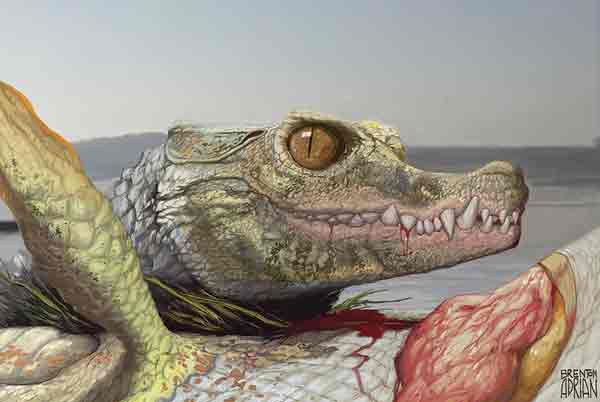Scolomastax sahlsteini – A Fearsome Cretaceous Crocodile Critter
The Woodbine Formation of eastern Texas has provided palaeontologists with another crocodyliform to study. The strata represent sediments laid down in a river delta system during the early stages of the Late Cretaceous (Cenomanian faunal stage). The vertebrate fossils found include dinosaurs, turtles, lungfish and several different types of crocodile including the fearsome Deltasuchus (D. motherali), that was named and described in 2017: Deltasuchus – A Dinosaur Crunching Crocodile.
Joining the list of crocodiles known from this location is Scolomastax sahlsteini, a much smaller animal that probably specialised in hunting fish and other small vertebrates. Its discovery reinforces the idea that there was niche partitioning in crocodyliforms associated with these sediments, that is, each genus focused on catching different types of prey and therefore avoided direct interspecific competition.
A Life Reconstruction of Scolomastax sahlsteini
Picture credit: Brenton Adrian (University of Tennessee)
An Insight into the Cretaceous Ecosystem of Appalachia
Scolomastax sahlsteini lived approximately 96 million years ago. It has been described from a partial jawbone and this species differs from other prehistoric crocodyliforms associated with this fossil location in having a shortened mandible, reduced tooth count, heterodonty (teeth of different shapes), a dorsally expanded surangular and enlarged attachments for powerful jaw muscles.
Scolomastax sahlsteini
Scolomastax may have been not much bigger than a dwarf crocodile (Osteolaemus spp.), the smallest living crocodile species, but at around 1.5 metres in length, it had a formidable bite and was probably best avoided. Writing in the academic journal “The Anatomical Record”, the researchers conclude that Scolomastax may have specialised in eating shellfish, or turtles (durophagous diet). Scolomastax may even have been an omnivore, supplementing its diet with plant material. The fossils from this location (the Arlington archosaur Site), have provided palaeontologists with an insight into the fauna of the eastern part of the North America (Appalachia).
Commenting on the significance of the discovery, one of the co-authors of the scientific paper, Stephanie Drumheller-Horton, a palaeontologist at the University of Tennessee stated:
“People sometimes think that crocs haven’t changed much since the age of dinosaurs, but that just isn’t true. This little croc has several weird features that make us think it ate hard prey items and maybe even plants. We don’t have anything like it alive in the world today.”
A Geographical Puzzle
Co-author, Associate Professor Alan Turner (Stony Brook University), added:
“S. sahlsteini is part of a group of early croc relatives called paralligatorids. Most members of this group are from Asia, but we are starting to have a few examples of them from Texas. This helps us understand how groups were dispersing between Asia and North America prior to the closing of the Western Interior Seaway, the inland sea that split North America in two.”
The genus name means “pointed stake jaw”, whilst the species epithet honours long-time volunteer Arthur Sahlstein, who found the fossil jawbone. A phylogenetic analysis places this new genus within the Eusuchia, specifically a member of the Paralligatoridae and a sister taxon to Paralligator gradilifrons, which is known from Upper Cretaceous rocks of the Gobi Desert (Mongolia).
Scolomastax sahlsteini extends the record of paralligatorids into the Late Cretaceous (Cenomanian faunal stage) of North America. The jawbone fossil represents the first appearance of this clade on the poorly known landmass of Appalachia, supporting a biogeographic connection between North America and Asia in the Early Cretaceous prior to development of the Western Interior Seaway. The authors of the paper conclude that further analysis of the Paralligatoridae family is required in order to determine appropriate phylogeny.
The scientific paper: “An Enigmatic Small Neosuchian Crocodyliform from the Woodbine Formation of Texas” by Christopher R. Noto, Stephanie K. Drumheller, Thomas L. Adams and Alan H. Turner published in The Anatomical Record.
Everything Dinosaur acknowledges the assistance of a press release from the University of Tennessee (Knoxville) in the compilation of this article.
The Everything Dinosaur website: Everything Dinosaur.







Leave A Comment